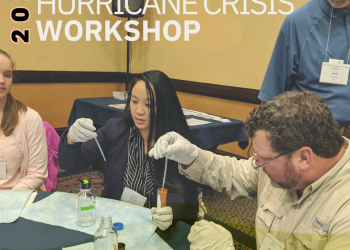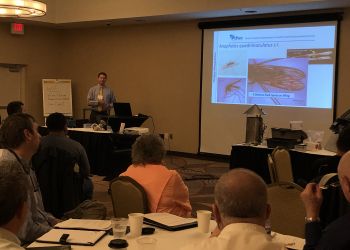For the last several months, NACCHO has featured the progress that communities across the country have made in retail food protection through a blog series on the U.S. Food & Drug Administration’s (FDA’s) Voluntary National Retail Food Regulatory Program Standards (Retail Program Standards).
The Retail Program Standards are designed to help food regulatory programs enhance the services they provide to the public. Each post in the blog series focuses on a different standard, highlighting the experiences, challenges, and successes of jurisdictions that have worked toward that standard.
 All jurisdictions featured have participated in NACCHO’s Retail Program Standards Mentorship Program, which provides peer-to-peer assistance and intensive technical support to help jurisdictions conform with the standards efficiently and effectively.
All jurisdictions featured have participated in NACCHO’s Retail Program Standards Mentorship Program, which provides peer-to-peer assistance and intensive technical support to help jurisdictions conform with the standards efficiently and effectively.
We are completing the blog series today, June 7, in honor of World Food Safety Day. To round out the series we are focusing on Standard 9: Program Assessment, and we are featuring Wake County Division of Environmental Health and Safety and Summit County Public Health:
- Andre C. Pierce, Director, Division of Environmental Health and Safety, Wake County, NC
- Maya Kulick, Senior Environmental Health Specialist, Summit County Public Health, Frisco, CO
What steps did you take to get started in your work on Standard 9?
Pierce: Our FDA Retail Food Specialist Donna Wanucha provided great support prior to getting started. She encouraged us to conduct a baseline survey of risk factors in our retail establishments sooner rather than later so we would be able to measure the effects of our work with the Retail Program Standards. Donna shared a data collection manual that gave an overview of what to expect during the study, with specifics about categorization, sample size, and randomization. We chose to use a survey instrument similar to a previous FDA survey tool so we could compare our results to national risk factor data. During our face-to-face training with Donna, we focused on the survey instrument, marking instructions, and reference materials, ending with field visits to help us standardize our observations.
Kulick: Summit County had already met and been audited on Standards 2 and 7 prior to working on Standard 9. Originally, we were under the false impression that Standard 9 was the last standard we should tackle. However, with guidance from other jurisdictions in Colorado, it became clear that it was important to develop sooner rather than later. We reviewed reports from several other Colorado jurisdictions that had already met Standard 9 prior to beginning our survey.
What was your biggest challenge in working toward Standard 9, and how have you worked to overcome that challenge?
 Pierce: We chose to collect data during non-compliance visits. The biggest challenge was the time to conduct field evaluations and evaluate the collection data (quality assurance). To address these challenges, we extended our project duration to over six months so we could pace ourselves and celebrate milestones. The quality assurance also took a lot of time, so we added short weekly meetings and instituted peer review each week. We also chose to evaluate each facility type separately. It took a little more time, but in terms of quality it kept our focus on processes common to specific types of facilities. The extended project duration and weekly interpretation meetings made the project seem less overwhelming.
Pierce: We chose to collect data during non-compliance visits. The biggest challenge was the time to conduct field evaluations and evaluate the collection data (quality assurance). To address these challenges, we extended our project duration to over six months so we could pace ourselves and celebrate milestones. The quality assurance also took a lot of time, so we added short weekly meetings and instituted peer review each week. We also chose to evaluate each facility type separately. It took a little more time, but in terms of quality it kept our focus on processes common to specific types of facilities. The extended project duration and weekly interpretation meetings made the project seem less overwhelming.
Kulick: Standard 9 was particularly difficult for our agency because our inspection database changed in the middle of our work. There was not a pre-made report to run that would get us the data we needed. We had to work with the program administrators to pull data and manipulate it, in some cases manually, in order to obtain the data we needed. We anticipate another hurdle when we do our next survey in two years because Colorado shifted from a Colorado-specific food code to the 2013 FDA Food Code in order to be Standard 1 compliant. We will have to map each violation back to the Colorado code from the initial survey. In anticipation, we mapped each Colorado violation to a foodborne Illness risk factor, but there will likely be some discrepancies, which we will account for in our next report.
What outcomes and benefits came out of working on Standard 9?
Pierce: Our 2010 baseline study, conducted prior to adoption of the FDA Food Code, helped us decide which risk factors we should target with training. The data from the second study in 2015 showed improvements in each of the risk factors. The results helped us articulate the positive impact in the community to stakeholders, policy makers, and staff, and gives credibility to a program focused on outcomes.
Kulick: In retrospect, we wish a baseline survey was the first step we took in adopting the Retail Program Standards. Standard 9 is essential to discerning if other interventions are successful. We hope that as more jurisdictions work on this standard, information is shared and best practices can be standardized. There were some surprises, including that our grocery stores had a high rate of cooling violations compared to other types of facilities. Because so many grocery stores do not conduct cooling, that would have been lost if we didn’t have the “non-applicable” categorization.
How do you sustain momentum in your work on Standard 9?
Pierce: The purpose of the retail food program is to reduce risk factors associated with foodborne illness. Staying focused on that outcome rather than simply measuring the number of inspections or inspection scores is what it’s all about. To sustain momentum in the work of Standard 9, it’s important to communicate the purpose of our work to staff, the Board of Health, and budget analysts.
Kulick: Because of adopting Standard 7, Summit County already has a biannual Food Safety Forum. During these meetings we are able to discuss strategies with industry and let them know trends we are seeing. Also, collecting emails during routine inspections allows us to send out guidance on an ongoing basis to a majority of our regulated facilities. The data was initially reported to county management and will be reported as further surveys are conducted.
What tips do you have for other jurisdictions working toward Standard 9?
Pierce: Reach out to your FDA Regional Specialist or other colleagues who have conducted a study for advice. I recommend picking one of the facility types and starting with that, then proceeding to the next type. That way, you’ll become familiar with the food processes, and at the same time you’ll be able to celebrate early accomplishments.
Kulick: Work on it prior to other standards. Review reports from other jurisdictions that are Standard 9 compliant. See if your database can easily pull reports or if they need to be developed internally.
How has your work on the Retail Program Standards overall affected your community in terms of public health outcomes?
Pierce: Our two risk factor studies show improvements in each of the five risk factor categories over a five-year period. This can be attributed to the educational outreach, focus on risk-based inspections, and our improved regulatory foundation. Working with our food service advisory committee has provided a venue to share the community successes, hear industry concerns, and develop relationships based on the common goal of food safety. The Retail Program Standards offer benchmarks that guide best practices. The Standards also provide opportunities for networking with others who are focused on quality improvement.
Kulick: Colorado was able to adopt higher licensing fees based on compliance with Standards 2 and 3. It has been worthwhile to put many of the practices in writing and to verify that staff are following procedures on a routine basis. The small AFDO grants have been a great incentive to continue pursuing Standards.
Look back at all of the posts in the blog series here, and stay tuned for the call for applications for NACCHO’s 2019-2020 cohort of the Retail Program Standards Mentorship Program in early September, pending funding.
Contact Amy Chang at [email protected] with any questions.






